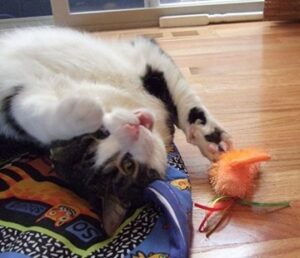-
Adopt
-
Veterinary Care
Services
Client Information
- What to Expect – Angell Boston
- Client Rights and Responsibilities
- Payments / Financial Assistance
- Pharmacy
- Client Policies
- Our Doctors
- Grief Support / Counseling
- Directions and Parking
- Helpful “How-to” Pet Care
Online Payments
Referrals
- Referral Forms/Contact
- Direct Connect
- Referring Veterinarian Portal
- Clinical Articles
- Partners in Care Newsletter
CE, Internships & Alumni Info
CE Seminar Schedule
Emergency: Boston
Emergency: Waltham
Poison Control Hotline
-
Programs & Resources
- Careers
-
Donate Now
 By Lisa Maciorakowski, DVM
By Lisa Maciorakowski, DVM![]()
angell.org/generalmedicine
generalmedicine@angell.org
617-522-7282
Sharing our lives with feline friends can bring much fulfillment and joy. However, kitties can demonstrate behaviors that are difficult for their owners to tolerate. But with some patience and understanding of why cats behave the way they do…we can often redirect their actions to keep everyone happy. Below are some common undesirable cat behaviors and some suggestions on how to alter them.
1. Scratching furniture: As much as we don’t want to have our cats scratching up our furniture, it’s important to remember that it’s a natural behavior for them. Cats scratch to stretch their muscles, to sharpen/shed their nails and to mark their territory by leaving scent marks. The best way to redirect your kitty from scratching the furniture is to provide plenty of alternative options in the form of scratching posts. If your cat is scratching at rugs then they would likely prefer a horizontal scratching post. If your cat is scratching at couch or table corners then providing vertical posts would be best. It is important to make sure that the post is long enough to allow for a big, full-length stretch and that it is sturdy enough that it won’t topple. Cats tend to like carpet and corrugated cardboard material but there is much individual preference for that as well. Make sure to consider your cat’s scratching preference and substitute similar objects for her to scratch.
 Since cats like to mark their territory, it is best to place the posts at room entrances, near their favorite resting areas and in places where they like to congregate. In multiple cat households it is best to have several posts of various positions and types around the house. If your cat does not take to the scratching posts you provide right away, you may need to place them directly next to the object you want them to stop scratching and cover THAT object with something your cat would not like – such as double-sided sticky tape, sheets of sandpaper, or aluminum foil. Alternatively, that object could be sprayed with a safe, though unpleasant (for your cat) scent like citrus or perfume. Then very gradually—no more than a few inches per day—the post can be moved to a more suitable location, though it is still best to keep the post as close to the area that your cat prefers. Having multiple scratching posts provides your cat with acceptable places to leave their mark without ruining furniture and carpets.
Since cats like to mark their territory, it is best to place the posts at room entrances, near their favorite resting areas and in places where they like to congregate. In multiple cat households it is best to have several posts of various positions and types around the house. If your cat does not take to the scratching posts you provide right away, you may need to place them directly next to the object you want them to stop scratching and cover THAT object with something your cat would not like – such as double-sided sticky tape, sheets of sandpaper, or aluminum foil. Alternatively, that object could be sprayed with a safe, though unpleasant (for your cat) scent like citrus or perfume. Then very gradually—no more than a few inches per day—the post can be moved to a more suitable location, though it is still best to keep the post as close to the area that your cat prefers. Having multiple scratching posts provides your cat with acceptable places to leave their mark without ruining furniture and carpets.
2. Biting/attacking hands or feet: It’s important to understand that a cat’s natural instinct is to pounce. They used to have to pounce on their prey while hunting. Having things to stalk and pounce on also makes them happy and helps to keep them healthy and active. Having a kitten jump on your moving feet can be cute for a little while, but no one wants a grown cat doing this. So right from the start it’s important not to use your body parts as “toys” with your kitten or new cat. If they start to initiate that kind of play it is important to not react in any way, as any reaction can be considered “exciting” for them. A non-response with an immediate re-direction to an appropriate play toy should be done. Cats have a wide variation in preference in type of toys which could mimic either birds, mice or bugs out in the wild. It is important to try and figure out which would be preferred by your cat and keep a rotation going so they do not get bored.
3. Jumping onto counters: Cats will often jump onto counters. Some of the reasons for this behavior is that they love heights, sometimes they find tasty treats and love dripping water from faucets. There are some strategies that can be used and found to be effective if employed consistently after you find the method that your cat responds to most positively. A deterrent of some sort along the edge of the counter could be used, such as double-sided sticky tape or aluminum foil. Additionally, if the cat requires assistance to get onto the counter (e.g., jumping on a chair first), try to eliminate that booster for a while. Keep the countertop clean of tasty treats that could lure your cat up there to eliminate the temptation and the reward for the jump.
If the cat is drawn to dripping water, make sure you never leave it running. Also, make sure that their water bowl situation is satisfactory with several fresh clean water bowls around. Cats seem to prefer large diameter bowls in various locations that are not in stressful areas. If it’s the flow of water they like, then a water fountain on the floor could be given specifically for them.
Make sure to provide a number of desirable alternative jumping/climbing targets. Also, make sure to provide plenty of praise in the form of petting and treats when they are found using the alternative jumping/climbing target so that they can associate their use with positive feelings.
Although it is often temporarily effective to get a cat off your counter using a water spritz or shaking a noisy full can, cats respond best to positive reinforcement rather than punishment. One way to do this is with clicker training. If you see your cat on the counter, offer a treat or other reward like a toy by throwing it on the floor to entice them off. Once they jump off pair the reward with the clicker that makes a sound. Eventually your cat will associate the clicker with the reward and the clicker itself can be used to lure the cat off the counter.
4. Eating too fast: Some cats gobble their meals up so quickly that it will result in them regurgitating their food soon after. Eating too quickly may be a result of boredom, competition eating if there are other cats in the home, or they may just be very hungry after not having had a meal for a while prior. To slow down their eating, try using a non-conventional bowl. Instead of having a flat bottom, these have raised portions that the cat has to navigate around in order to eat the food. Otherwise, you could add in some inedible obstacles. Cat treat toys and slow feeders are also good options as they slowly release bits of kibble as the toy is maneuvered around by the cat. There are also automatic feeders that can release small portions of food at a certain timed interval. When cats eat small bits at a time it helps prevent them from gulping and regurgitating. Employing these methods can often keep floors cleaner and cats happier and can provide entertainment for them as well.
 5. Chewing on unusual substrates: Many cats find a fascination with chewing on some strange objects like wires/cords, house plants, paper, plastic or other fabric – kittens will chew on objects when they are teething and cats continue to explore the world with their mouths by chewing on things. Unfortunately, this can sometimes get out of hand and be dangerous to the cat and damaging to your belongings. Once a medical issue is ruled out, the most likely underlying cause is boredom. By providing plenty of safe but fun and creative alternative play toys the cats will hopefully stay busy with those. Some toys that release treats are a good way to satisfy their hunting instincts. A good resource for ideas on how to provide kitties with an enriched environment is the Indoor Cat Initiative website (https://indoorpet.osu.edu/).
5. Chewing on unusual substrates: Many cats find a fascination with chewing on some strange objects like wires/cords, house plants, paper, plastic or other fabric – kittens will chew on objects when they are teething and cats continue to explore the world with their mouths by chewing on things. Unfortunately, this can sometimes get out of hand and be dangerous to the cat and damaging to your belongings. Once a medical issue is ruled out, the most likely underlying cause is boredom. By providing plenty of safe but fun and creative alternative play toys the cats will hopefully stay busy with those. Some toys that release treats are a good way to satisfy their hunting instincts. A good resource for ideas on how to provide kitties with an enriched environment is the Indoor Cat Initiative website (https://indoorpet.osu.edu/).
If electric cords are a particular target they should be kept out of reach as best as possible, or else covered with some other material. Sometimes bitter apple spray on them or double-sided sticky tape on the floor surrounding them will be good deterrents for cats.
Cats have a natural desire to chew plants and your live houseplants may become a target. Some of these plants can be extremely toxic to cats, and for your cat’s safety you need to recognize and get rid of these plants or keep them completely unavailable to your cat. The ASPCA website provides a list of toxic plants (https://www.aspca.org/pet-care/animal-poison-control/toxic-and-non-toxic-plants).
When cats chew on wool or other soft fabrics it is often thought to be either soothing or an obsessive compulsive disorder (OCD)-type of behavior. If you can’t keep the object completely away, try to discourage this behavior by spraying a bitter apple on the area that you don’t want them to chew but then also provide them with a similar but alternative, “allowed” chewing source.
It is important to remember that, particularly for cats, it is not effective to ever hit or yell at them when you are upset. They will not associate what you consider bad behavior with the negative reinforcement you are intending. Instead, they will just become scared of you. By understanding that these behaviors come from natural instinct and not any malintent, we can use some of the above techniques to redirect their natural behaviors so that everyone can live in harmony.